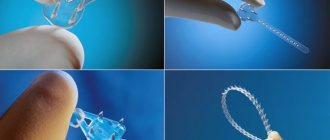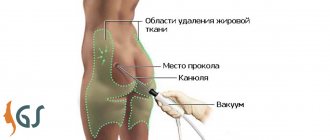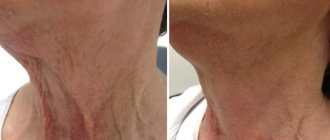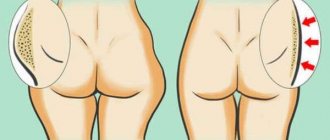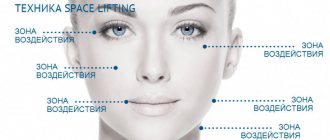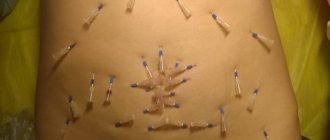Types of techniques
Experts know how to improve the buttocks using several methods:
- Installation of implants (gluteoplasty) . Silicone or saline-filled endoprostheses are placed under the large muscle or fascia. The size and shape are selected according to the patient's wishes and anatomical capabilities. For a flawless appearance of buttocks with implants, a sufficient amount of muscle tissue is necessary. They should not stand out when bending or other movements. Lifetime warranty on implants.
- By lipofilling method . The operation involves using the patient's own fat tissue. It is taken from other parts of the body, processed in a special centrifuge and injected under the skin. There is another way to place fat cells - under the gluteus maximus muscle, it gives a more aesthetic result. Lipofilling is a less traumatic intervention compared to the previous one, but your own tissues tend to dissolve. Therefore, the result may not last long.
- Using biothreads . This is rather a method of tightening a problem area, providing a chance to make the buttocks more pronounced without enlargement. First, threads compatible with living tissues are placed in this area, which are secured with clamps along the border of the large muscle. After some time, when the body adapts to the material, their ends tighten further. The gluteal muscle contracts and acquires a more protruding shape in this way.
- Simple lift . Sometimes, to return to the previous position and visual increase, just such an intervention is enough. The surgeon excises excess tissue, moves it upward and secures it. The operation is often combined with lipofilling and implantation.
Using the methods listed above, you can correct any defects in the problem area. But most of the fair sex strive to undergo Brazilian augmentation. This is a special, very feminine, rounded and outstanding shape that can be achieved using one of the methods. If a Brazilian buttock surgery is performed, it is easy to discern big changes before and after.
To learn how Brazilian buttock surgery is performed, watch this video:
Kinds
Gluteoplasty is an operation to reshape or lift the buttocks using implants. There are several types of butt plastic surgery. To choose the right method, you need to know about their advantages and disadvantages, as well as the effectiveness of each method. After the operation, stitches remain to make them less noticeable, surgeons choose different angles of incisions:
- horizontal is made in the upper part of the buttock ;
- obliquely - the seam will pass from the side, in the groin area;
- along the gluteal groove is the most common option.
The suture option along the gluteal groove is chosen by most surgeons, since it hides the scar from the operation by a natural muscle fold. For any type of incision, it is closed with a cosmetic suture. It is worth remembering that plastic surgery is in any case an intervention in the body.
After which there will be a rehabilitation period. In order to see the final result, you need to wait until all the hematomas and bruises disappear. It will take several months for the skin and muscles to come into shape and for the body to get used to the implant.
Endoprosthetics
Endoprosthetics is a method of increasing or correcting the gluteal muscles using implants.
The essence of the method is to install implants under the gluteus maximus muscle, inserted under the superficial gluteal fascia or intramuscularly. In terms of their structure, buttock implants are not much different from breast implants. There are three forms of implants:
- oval;
- teardrop-shaped;
- round.
Teardrop implants reverse physical disabilities resulting from injury. The remaining forms are intended for correction of the buttocks. The structure of implants can be smooth or textured. The latter are more preferable as they hold their shape better. Smooth implants are less durable than textured ones.
Endoprosthesis replacement is carried out after a full consultation with the surgeon, who collects the patient’s entire medical history. The doctor, together with the patient, selects the desired shape and size of implants. The buttock augmentation surgery itself lasts about 2 hours and is done under general anesthesia. Implants are made from materials that are safe for humans.
The advantage of this type of plastic surgery is the naturalness of the buttocks, both in appearance and to the touch. Buttock implants are filled with gel and have shape memory.
Since the buttock is one of the most mobile muscles, implants of increased strength are installed. One of the disadvantages is a lifelong ban on injections into the gluteal muscle; all injections can only be given in the thigh. The injection may damage the implant.
Endoprosthetics is a popular type of plastic surgery in the world. It has earned recognition due to its effectiveness. This is a quick and fairly affordable way to give your buttocks the desired shape and volume. Almost every clinic offering plastic services offers endoprosthetics.
Lipofilling
A fairly new, but very effective way to lift the buttocks. The injection into the muscles is carried out from the patient's own subcutaneous fat. This operation is recommended after 25 years. The method is great for restoring the symmetry of the gluteal muscles or for strengthening them if exercise does not help.
The operation is prescribed by the surgeon after the patient has passed all the tests:
- blood and urine tests ;
- biochemistry ;
- coagulogram;
- ECG.
Lipofilling can be performed under various types of anesthesia: general, local or epidural anesthesia. The entire operation lasts 1 – 1.5 hours. Lipid tissue is inserted through small incisions in the buttock, creating the desired shape.
The advantage of lipofilling is that the patient will not experience rejection. Since the injected fat is taken from the patient himself, the muscles of the buttocks accept it without problems. The shape of the buttocks becomes ideal and looks absolutely natural. Also, due to the naturalness of the material, the rehabilitation period proceeds without complications. The muscles become elastic and toned.
There are several disadvantages to the operation. It is recommended only after 25 years. The effectiveness of the operation lasts up to 3 years, after which the procedure must be repeated.
Filamentlifting
Philmantlifting is an outpatient surgery, better known as a butt lift with Brazilian threads. The operation gives incredible shape. There are several types of threads that are used for lifting:
- polypropylene threads;
- polylactic threads ;
- mesothreads
This lift is done when there is slight sagging of the gluteal muscles, as well as cellulite. The Brazilian lift is considered one of the most effective if you need to make a minor correction.
The result is firm and round buttocks. The threads are inserted under the skin and secured into soft tissues using special notches. The surgeon performs the operation within 1 hour under local anesthesia. The doctor tightens the threads to fix the tissue.
The advantage of filament lifting can be considered the ability to combine it with liposuction and lipofilling. The postoperative period passes quickly without any complications. The operation leaves no scars or scars. The downside is that the operation has an effect for 3 years, after which the procedure must be repeated.
Contraindications to this method of leg lift:
- pregnancy or feeding;
- tendency to form keloid scars;
- sensitivity and inflammation of the skin at the sites where the threads are inserted;
- heat .
Surgical excision of sagging tissue
An option for buttock correction and thigh lift without implants is surgical excision of sagging tissue. This operation is performed if a radical change in the buttocks is necessary or if there is excess weight. In this case, surgery is intended more to reduce the size of the buttocks.
This operation can be performed together with gluteoplasty. The operation is performed by a surgeon after a complete examination of the patient.
Before the operation, the doctor, together with the patient, determines the future shape of the butt and hips. Surgery time depends on the amount of tissue that needs to be removed. Excision of sagging tissue is performed under general anesthesia.
The advantage of this method of buttock correction is its durability. If the patient does not experience significant changes in weight, the effect of the operation will not disappear.
Disadvantages of surgical excision:
- long and painful recovery period;
- the need for extensive physical exercise for recovery;
- total load on the patient's body.
Indications for use
Sometimes you can improve the shape and volume of your buttocks with the help of exercises. But sport is not always able to correct the shortcomings of this area. This means that the patient has one or more indications for plastic surgery:
- small buttocks, disrupting the harmony of the contours of the figure;
- ptosis of soft tissues in this area;
- muscle atrophy in the buttocks;
- changes in soft tissues caused by diseases and injuries that led to a violation of the aesthetics of appearance;
- asymmetry of the gluteal muscles.
Details of femoroplasty
In order to create a new silhouette, femoroplasty can be performed in combination with other operations.
It is often combined with butt lift, abdominal skin tightening, and liposuction. Carrying out liposuction before femoroplasty is very reasonable, since significant volumes of fatty tissue are not removed during a thigh lift - femoroplasty is aimed specifically at tightening the skin and shaping contours. When a thigh lift is performed as an independent operation, it lasts 2-2.5 hours. If additional corrective manipulations are required, the operation time increases.
The technique of femoroplasty is discussed between the doctor and the patient at preliminary consultations. Typically, general anesthesia is used for femoroplasty, but spinal anesthesia can be used.
- If the sagging skin is not too pronounced, then it is usually enough to tighten it on the inner thighs
. When lifting the inner thigh, an incision is made in the groin folds, then excess skin is removed along with the subcutaneous fat layer. - If the outer thighs
, the incision is directed from the groin area around the hip joint. - When a thigh and buttock lift is performed at the same time
, the incisions will be oval in shape and pass through the hips and upper buttocks. - The technique for lifting all sides of the hips
- outer, inner, front and back - involves an incision from the bend of the buttocks along the groin folds.
After the lift is completed, the incisions are sutured - this is an equally important stage of the operation, since if the sutures are applied carelessly, tissue displacement or deformation of the external genitalia may occur. Drainage tubes are placed in the incision hole to prevent blood from pooling in the wound. After completion of the operation, the patient is immediately put on compression garments.
Contraindications
Gluteoplasty and other types of intervention are not performed even if there are indications for them, if there are the following problems:
- serious pathologies of internal organs;
- acute period of chronic disease;
- blood clotting disorder;
- endocrine pathologies;
- obesity;
- acute infections;
- cardiovascular diseases.
During pregnancy, menstruation and lactation, surgery is also not performed.
We recommend reading the article about silicone breasts. From it you will learn about the types of implants, methods of surgery, healing time, unsuccessful results, and the cost of the procedure.
Preparing for Change
The intervention is a serious test for the body, so it should be approached prepared. This is especially important when plastic surgery of the buttocks with implants is planned - the most traumatic operation, performed under general anesthesia and supplemented by long-term rehabilitation.
The first thing you need to do after consulting a surgeon is to undergo an examination consisting of:
- general blood and urine tests;
- biochemistry, coagulograms;
- research for HIV, syphilis;
- ECG, fluorography.
If the results do not reveal any contraindications, then preparation for the operation should proceed for two weeks:
- stop taking blood thinning medications and drinking alcohol;
- you need to stop smoking;
- food all this time should be sufficient, without excesses and strict restrictions;
- should not sunbathe;
- you need to try not to catch a cold;
- the last meal before surgery should be 8-10 hours before surgery;
- You should get a good night's sleep the night before the intervention.
How is the procedure performed?
The surgeon's actions during the operation are determined by its type. It is performed under general anesthesia or epidural anesthesia. If the buttocks are improved with threads, local anesthesia is used. Mandatory steps for any intervention are marking the skin and antiseptic treatment of its surface.
Otherwise, plastic surgery of the hips and buttocks of different types has nuances:
- Implantation of endoprostheses requires cutting the skin in a natural fold and forming pockets. A silicone device is placed under the muscle or fascia, straightened, and sutures are applied. Typically, the material for fixing tissues separated by a scalpel is absorbable and does not require later removal. The operation takes 1.5 - 3 hours.
- lipofilling begins with pumping out fat from problem areas of the body (usually the stomach and sides). The material is then cleaned of excess impurities in a centrifuge. Fat tissue is injected into the buttock area at different points, aiming for uniform distribution. The resulting punctures are sealed with a special plaster. The operation lasts 1 - 1.5 hours.
To learn how to enlarge the buttocks using fat tissue obtained through abdominal liposuction, watch this video:
- The threads are introduced in a fan pattern using thin needles or cannulas, placing them from bottom to top. When they are all in place, the auxiliary devices are removed. The threads are pulled (living tissues are “selected” together with them), the protruding ends are cut off. Punctures are treated with an antiseptic and sealed with a band-aid. The process lasts 30 - 40 minutes, then you need to apply cold for an hour.
Rehabilitation period after liposuction
After the procedure for reducing the volume of the buttocks and thighs by liposuction, severe pain in the intervention area is possible for several days. Swelling, numbness, compaction, and swelling are also possible. These phenomena may be accompanied by general weakness and increased body temperature. Due to the possibility of such effects, patients should remain in the clinic for at least 24 hours after surgery.
For two months after liposuction, it is necessary to limit physical activity on the legs - this will prevent tension at the incision sites and protect them from friction until final healing. For 3-5 weeks, special compression garments should be worn constantly, and for another 6-8 weeks - only during the daytime. The result of liposuction of the thighs and buttocks can be finally assessed only after six months, when postoperative swelling has completely disappeared and the fatty tissue has been evenly distributed.
Rehabilitation after
Even such a simple and low-traumatic procedure as buttock contouring is complemented by a recovery period. Moreover, it will be needed if a full-fledged operation was carried out. During rehabilitation you need:
- Spend some time in the clinic. When enlarging the buttocks with implants, this is 2 - 3 days, in other cases - until the end of the anesthesia.
- Do not shower for 2 - 3 days after surgery. This will help avoid infection.
- The first week after implantation you should only lie on your stomach. For the next 20 - 30 days, it is better to sit as little as possible to allow the buttocks to take on the most natural and beautiful shape.
- For 4 - 6 weeks you should not overheat or overcool. Sauna, solarium, hot bath are prohibited.
- Physical activity should be limited for at least a month. And when using implants it is excluded.
- You should not drink alcohol during the entire rehabilitation period. Smoking is also undesirable.
- Be sure to wear compression garments. After implants - 2 - 3 months, after lipofilling - 3 - 4 weeks.
- To relieve pain that bothers you after the anesthesia wears off, you can take pills. Which ones exactly, it’s better to ask your doctor.
- After the stitches have healed, they can be smeared with products that promote the formation of subtle scars. This is Kontraktubeks and others like it.
Rehabilitation after the introduction of threads is shorter. It does not require wearing compression garments, but other restrictions remain in effect.
Features of alternative thigh lift surgery (femoroplasty)
The operation lasts 3-3.5 hours and is usually performed under general anesthesia. However, it is possible to perform the operation under epidural anesthesia, when only the lower half of the body is anaesthetized.
After the incision is made, liposuction is performed and then the excess tissue is distributed. Depending on the operation, suturing can be performed with either regular or absorbable threads. The next day after the operation, the patient can go home. However, it is recommended to avoid strenuous physical activity for the first few days. To support the inner thigh, it is recommended to wear compression garments for the first two weeks after surgery.
If you have questions about the specifics of alternative thigh lift surgery, you can ask them to the consultants of the Mont Blanc clinic by calling the numbers listed on the website.
Possible complications
Enlargement of the buttocks with plastic surgery can add new problems. More often they occur when using implants. But both lipofilling and the introduction of threads into living tissue can be accompanied by complications. The general list looks like this:
- Seromas, hematomas and granulomas . Formations can occur after any type of intervention.
- Infection . Infiltration of bacteria is possible through threads, fatty tissue and during implantation.
- Formation of irregularities, asymmetry of the buttocks . This is possible due to contouring of the threads, tissue retraction at the puncture sites, uneven distribution of fat and displacement of the implant.
- Changes in the sensitivity of the operated area . The buttock area may hurt for a long time, be constantly cold, or, on the contrary, become numb. This occurs against the background of damage to nerves, blood vessels, and their chronic traumatization by the very presence of foreign bodies.
- Implant rejection . It manifests itself as inflammation, pain, and prolonged healing of sutures. This happens due to the characteristics of the body or the endoprosthesis is too large.
- Change in gait . This is more likely if gluteoplasty was performed. In this case, damage to the sciatic nerve is possible. The problem can be temporary, but sometimes it remains for a long time.
The price of a beautiful butt
The cost of even one type of surgery to correct the size and shape of the buttocks in different clinics may vary. It depends on the qualifications of the doctor, the type of implants, threads, other materials and equipment. Lipofilling will cost from 900 euros and more, plastic surgery of the buttocks without implants (surgical lift) will cost from 1800 euros. And the use of endoprostheses is possible at the same price plus the cost of them themselves. Enlargement and tightening with threads will cost no less than 700 euros.
It will be possible to make plastic surgery on the buttocks at a considerable cost of money and time. But if there is a problem that affects self-esteem, the result is worth it. When planning an operation, you should carefully choose a clinic and a doctor, how to prepare for the intervention and take recovery seriously. Then the effect will last for at least 2 - 3 years after the introduction of threads, for a longer time after lipofilling and installation of implants.
Similar articles
- Buttock augmentation with a hyaluronic mixture: how to administer it...
Buttock augmentation with hyaluronic acid will help make your butt more expressive, remove asymmetry or sagging. How are injections administered? How many of them do you need? How long does the effect last if augmentation is done using hyaluronic acid? Read more - Thighplasty: inner and outer surfaces...
If the skin on the thighs is sagging or, conversely, fat interferes with normal life, thigh plastic surgery on the inner and outer surfaces will help. Increase or decrease is possible with the procedure. But the before and after result is inspiring. Read more
- Brazilian buttocks massage: technique…
A Brazilian butt massage will help you get a butt like Jennifer Lopez's. The technique causes some concerns among women, but it is painless and safe. But the result before and after the massage is impressive. Read more
- Ptosis of the buttocks: how to remove it, will surgery help get rid of it?
If ptosis of the buttocks occurs, it is not easy to remove. Initial correction can be done with physical exercises; to a more complex extent, surgery will help. What are the ways to get rid of ptosis? Read more
Types of surgical lifting
- Internal lift.
This type of lift is also called a midline lift. When performing an internal lift, the incision is made along the inguinal folds. Part of the skin from the side of the thigh is removed, so when the surgical wound is sutured, the inner surface of the thigh is tightened. The method is suitable for those who have slight sagging tissue on the inner thigh.
- Vertical lift.
With this method of surgery, the incision goes down the inner surface of the thigh from the inguinal fold to the knee. Stepping back from the first incision, the surgeon makes a second incision so that a wedge of skin is formed, which tapers towards the knee. The skin between the incisions is removed, the edges of the surgical wound are brought together and stitched. A vertical lift is used when a large amount of stretched and lumpy skin needs to be removed.
- Spiral lift.
The incision goes around almost the entire surface of the thigh from the inguinal fold to the outer surface of the thigh, from there to the subgluteal fold and to the groin. Spiral (also known as external) lifting is most often used by adherents of extreme weight loss, when a large percentage of body weight is lost in a short period of time. Then the skin of the entire thigh needs lifting, both outside and inside, both front and back.
- Combined technique.
It is used in cases where the severity of ptosis of the thigh skin does not allow the defect to be corrected using only one type of lift. What types of surgical lifting will be combined is decided by the plastic surgeon himself, based on the degree of tissue sagging and the results that the patient expects.
How is the operation performed?
Surgical lifting is performed only under general anesthesia. It can be inhaled or intravenous. Spinal anesthesia in combination with the use of sedatives is less commonly used. The operation may take 2-2.5 hours. Incisions and tissue excision are carried out according to previously applied markings.
If surgical lifting is combined with liposuction, then liposuction is performed first, and then the skin is tightened. The way the edges of the wound are fixed largely determines the result of the operation.
A feature of the inguinal fold area is its relatively poor blood supply and innervation. Therefore, there is always a risk of slow healing and the formation of a rough, “disintegrated” scar.
To minimize the risk of severe scarring, most surgeons have now abandoned suturing the edges of the skin to each other. Now there are methods for layer-by-layer stitching of tissues with reliable fixation of the lower flap of skin, which will subsequently create conditions for the formation of a thin soft scar. After the stitches are placed, they are covered with a sterile dressing. The patient is put on compression garments, the purpose of which is to reduce tissue swelling and reduce the risk of hematoma formation.
Recovery period
You need to prepare for the fact that the entire recovery period takes about 6 months.
Video:
The initial recovery of well-being to the point where you can return to work takes 2-4 weeks.
- Staying in hospital.
The patient spends the first 2-3 days in the hospital to eliminate the risk of complications of anesthesia and the operation itself, such as bleeding or suture dehiscence. The patient is then discharged home and sees his or her surgeon for an outpatient appointment.
- Postoperative pain.
Pain, burning, and numbness may bother the patient for several days after discharge. Typically, such symptoms can be easily relieved by taking painkillers.
- Compression underwear.
Special shapewear must be worn for at least 1 month after surgery. It promotes faster resorption of edema, reduces pain, and is a prophylactic agent that reduces the severity of subcutaneous hematomas and pressure on surgical sutures.
- Postoperative sutures.
If sutures are placed on the skin with absorbable threads, then such sutures do not need to be removed. Non-absorbable suture material is removed 10-14 days after surgery.
As long as the sutures are not removed, they must be treated twice a day with antiseptic solutions.
You should not specifically massage the suture area or apply creams or ointments that accelerate healing, as this will increase swelling and can lead to infection of the postoperative wound.
- Mandatory restrictions for the postoperative period.
Such restrictions include:
- sports and any other intense physical activity in the first 2 months;
- thermal procedures (bath, sauna, warm bath) until the swelling is completely resolved;
- solarium until the scar is completely formed, so as not to cause its pigmentation (usually the first 12-18 months).
Despite the ban on playing sports, you cannot allow yourself to be completely immobile, as this can lead to the formation of blood clots in the veins of the legs.
Complications
- Deformation of the genital organs.
Postoperative incisions that run along the inguinal folds are sutured so that the skin is taut. This can lead to displacement of the skin in nearby areas, such as the skin of the groin. Because of this, the genitals can also shift and take an unnatural position.
- Formation of rough scars.
The tissues that form the scar are constantly in a tense state, so the scar that forms in the first two to three months is constantly stretched. As a result, instead of a thin whitish scar, a wide, rough, thick, protruding scar may form.
In many ways, modern surgical techniques used by plastic surgeons can reduce the risk of developing severe scars, but at the moment, none of these techniques can completely eliminate the risk of such a complication.
- Thrombosis.
The risk of developing thrombosis is especially high in those who took antiplatelet agents (drugs that reduce blood viscosity) before surgery and stopped taking them in order not to provoke bleeding during surgery. To prevent complications, it is recommended to avoid a long period of bed rest after surgery and early initiation of minimal physical activity, such as leisurely walking, etc.
- Bleeding or development of seroma.
Typically, collections of blood or tissue fluid are identified as a tense, bulging tumor at the site of the surgical wound. The growth of the tumor is accompanied by the appearance and intensification of arching pain. In this situation, a drainage tube is installed and the cavity is emptied of liquid. Performed in a hospital setting.
- Infection.
To prevent the development of infection in the wound after surgery, a course of antibacterial therapy is administered. Also, it is for this purpose that a drainage tube is left in the wound on the first day after surgery. If inflammation does develop, it is treated in a hospital setting.
How and why mastoptosis (breast drooping) develops, read about it in the article - mastopexy.
All details about cruroplasty of the legs at this address. See photos before and after inner thigh lift here.
